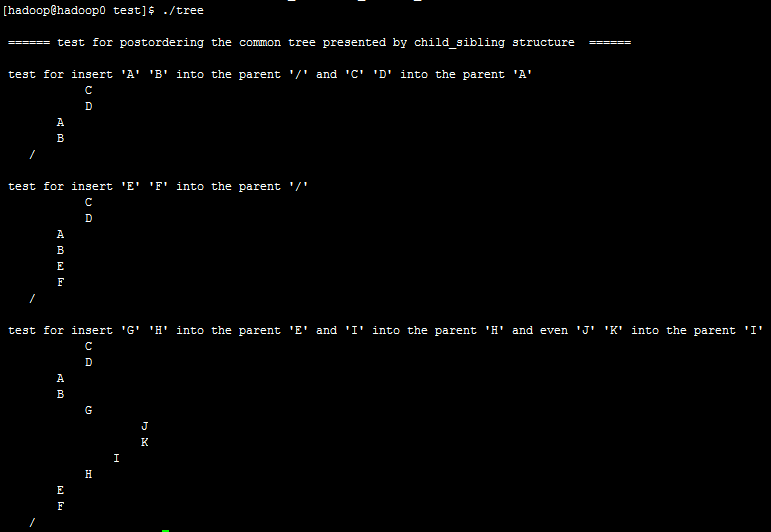利用树的先序和后序遍历打印 os 中的目录树
2015-10-19 21:55
253 查看
【0】README
0.1)本代码均为原创,旨在将树的遍历应用一下下以加深印象而已;(回答了学习树的遍历到底有什么用的问题?)你对比下linux 中的文件树 和我的打印结果就明理了;

0.2)我们采用的是 儿子兄弟表示法 来 表示树的整体节点构造;
0.3)儿子兄弟表示法介绍
0.3.1)如下图所示: 向下的箭头(左指针)指向第一个儿子节点, 从左到右的箭头(右指针)指向下一个兄弟节点;(间接说明了树的节点有两个指针)


0.3.2)树节点定义代码如下:

0.4)哥子第一次 使用这 丑到逼爆 的 编辑器,也是醉了,主要是markdown 对于源代码文件显示不够清晰, oh m g;
【1】任务来了
我们想要列出目录中所有文件的名字, 我们的输出格式将是:深度为 depth 的文件的名字将被 depth 次跳格缩进后打印出来;
【2】给出先序遍历+后序遍历目录树的实现代码
2.1)先序遍历步骤:
step1)访问根节点;
step2)先序遍历以儿子为根的子树;
step3)先序遍历以兄弟为根的子树;
download source code:https://github.com/pacosonTang/dataStructure-algorithmAnalysis/blob/master/chapter4/p68_preorder_common_tree.c
source code at a glance:
打印结果如下:

2.2)后序遍历步骤:(不同于二叉树的后序)
step1)后序遍历以儿子为根的子树;
step2)访问根节点;
step3)后序遍历以兄弟为根的子树;
download source code: https://github.com/pacosonTang/dataStructure-algorithmAnalysis/blob/master/chapter4/p69_postorder_commone_tree.c
source code at a glance:
打印结果如下:

0.1)本代码均为原创,旨在将树的遍历应用一下下以加深印象而已;(回答了学习树的遍历到底有什么用的问题?)你对比下linux 中的文件树 和我的打印结果就明理了;

0.2)我们采用的是 儿子兄弟表示法 来 表示树的整体节点构造;
0.3)儿子兄弟表示法介绍
0.3.1)如下图所示: 向下的箭头(左指针)指向第一个儿子节点, 从左到右的箭头(右指针)指向下一个兄弟节点;(间接说明了树的节点有两个指针)


0.3.2)树节点定义代码如下:
struct Tree;
typedef struct Tree *Tree;
// we adopt child-sibling notation
struct Tree
{
ElementType value;
Tree firstChild;
Tree nextSibling;
};
0.4)哥子第一次 使用这 丑到逼爆 的 编辑器,也是醉了,主要是markdown 对于源代码文件显示不够清晰, oh m g;
【1】任务来了
我们想要列出目录中所有文件的名字, 我们的输出格式将是:深度为 depth 的文件的名字将被 depth 次跳格缩进后打印出来;
【2】给出先序遍历+后序遍历目录树的实现代码
2.1)先序遍历步骤:
step1)访问根节点;
step2)先序遍历以儿子为根的子树;
step3)先序遍历以兄弟为根的子树;
download source code:https://github.com/pacosonTang/dataStructure-algorithmAnalysis/blob/master/chapter4/p68_preorder_common_tree.c
source code at a glance:
#include <stdio.h>
#include <malloc.h>
#define ElementType char
#define Error(str) printf("\n error: %s \n",str)
struct Tree;
typedef struct Tree *Tree;
Tree createTree();
Tree makeEmpty(Tree t);
Tree insert(ElementType e, Tree t);
// we adopt child-sibling notation
struct Tree
{
ElementType value;
Tree firstChild;
Tree nextSibling;
};
// create a tree with root node
Tree createTree()
{
Tree t;
t = (Tree)malloc(sizeof(struct Tree));
if(!t) {
Error("out of space, from func createTree");
return NULL;
}
t->firstChild = NULL;
t->nextSibling = NULL;
t->value = '/';
return t;
}
// make the tree empty
Tree makeEmpty(Tree t)
{
if(t){
makeEmpty(t->firstChild);
makeEmpty(t->nextSibling);
free(t);
}
return NULL;
}
//
Tree insert(ElementType e, Tree parent)
{
Tree child;
Tree newSibling;
if(!parent){
Error("for parent tree node is empty , you cannot insert one into the parent node, from func insert");
return NULL;
}
newSibling = (Tree)malloc(sizeof(struct Tree));
if(!newSibling) {
Error("out of space, from func insert");
return NULL;
}
newSibling->value = e;
newSibling->nextSibling = NULL;
newSibling->firstChild = NULL;// building the node with value e over
child = parent->firstChild;
if(!child) {
parent->firstChild = newSibling;
return parent;
}
while(child->nextSibling)
child = child->nextSibling; // find the last child of parent node
child->nextSibling = newSibling;
return parent;
}
// find the tree root node with value equaling to e
Tree find(ElementType e, Tree root)
{
Tree temp;
if(root == NULL)
return NULL;
if(root->value == e)
return root;
temp = find(e, root->firstChild);
if(temp)
return temp;
else
return find(e, root->nextSibling);
}
// analog print directories and files name in the tree, which involves preorder traversal.
void printPreorder(int depth, Tree root)
{
int i;
if(root) {
for(i = 0; i < depth; i++)
printf(" ");
printf("%c\n", root->value);
printPreorder(depth + 1, root->firstChild);
printPreorder(depth, root->nextSibling);
}
}
int main()
{
Tree tree;
tree = createTree();
printf("\n test for insert 'A' 'B' into the parent '/' and 'C' 'D' into the parent 'A' \n");
insert('A', tree);
insert('B', find('/', tree));
insert('C', find('A', tree));
insert('D', find('A', tree));
printPreorder(1, tree);
printf("\n test for insert 'E' 'F' into the parent '/' \n");
insert('E', find('/', tree));
insert('F', find('/', tree));
printPreorder(1, tree);
printf("\n test for insert 'G' 'H' into the parent 'E' and 'I' into the parent 'H' and even 'J' 'K' into the parent 'I' \n");
insert('G', find('E', tree));
insert('H', find('E', tree));
insert('I', find('H', tree));
insert('J', find('I', tree));
insert('K', find('I', tree));
printPreorder(1, tree);
return 0;
}打印结果如下:

2.2)后序遍历步骤:(不同于二叉树的后序)
step1)后序遍历以儿子为根的子树;
step2)访问根节点;
step3)后序遍历以兄弟为根的子树;
download source code: https://github.com/pacosonTang/dataStructure-algorithmAnalysis/blob/master/chapter4/p69_postorder_commone_tree.c
source code at a glance:
#include <stdio.h>
#include <malloc.h>
#define ElementType char
#define Error(str) printf("\n error: %s \n",str)
struct Tree;
typedef struct Tree *Tree;
Tree createTree();
Tree makeEmpty(Tree t);
Tree insert(ElementType e, Tree t);
// we adopt child-sibling notation
struct Tree
{
ElementType value;
Tree firstChild;
Tree nextSibling;
};
// create a tree with root node
Tree createTree()
{
Tree t;
t = (Tree)malloc(sizeof(struct Tree));
if(!t) {
Error("out of space, from func createTree");
return NULL;
}
t->firstChild = NULL;
t->nextSibling = NULL;
t->value = '/';
return t;
}
// make the tree empty
Tree makeEmpty(Tree t)
{
if(t){
makeEmpty(t->firstChild);
makeEmpty(t->nextSibling);
free(t);
}
return NULL;
}
//
Tree insert(ElementType e, Tree parent)
{
Tree child;
Tree newSibling;
if(!parent){
Error("for parent tree node is empty , you cannot insert one into the parent node, from func insert");
return NULL;
}
newSibling = (Tree)malloc(sizeof(struct Tree));
if(!newSibling) {
Error("out of space, from func insert");
return NULL;
}
newSibling->value = e;
newSibling->nextSibling = NULL;
newSibling->firstChild = NULL;// building the node with value e over
child = parent->firstChild;
if(!child) {
parent->firstChild = newSibling;
return parent;
}
while(child->nextSibling)
child = child->nextSibling; // find the last child of parent node
child->nextSibling = newSibling;
return parent;
}
// find the tree root node with value equaling to e
Tree find(ElementType e, Tree root)
{
Tree temp;
if(root == NULL)
return NULL;
if(root->value == e)
return root;
temp = find(e, root->firstChild);
if(temp)
return temp;
else
return find(e, root->nextSibling);
}
// analog print directories and files name in the tree, which involves postorder traversal.
void printPostorder(int depth, Tree root)
{
int i;
if(root) {
printPostorder(depth + 1, root->firstChild);
for(i = 0; i < depth; i++)
printf(" ");
printf("%c\n", root->value);
printPostorder(depth, root->nextSibling);
}
}
int main()
{
Tree tree;
tree = createTree();
printf("\n ====== test for postordering the common tree presented by child_sibling structure ====== \n");
printf("\n test for insert 'A' 'B' into the parent '/' and 'C' 'D' into the parent 'A' \n");
insert('A', tree);
insert('B', find('/', tree));
insert('C', find('A', tree));
insert('D', find('A', tree));
printPostorder(1, tree);
printf("\n test for insert 'E' 'F' into the parent '/' \n");
insert('E', find('/', tree));
insert('F', find('/', tree));
printPostorder(1, tree);
printf("\n test for insert 'G' 'H' into the parent 'E' and 'I' into the parent 'H' and even 'J' 'K' into the parent 'I' \n");
insert('G', find('E', tree));
insert('H', find('E', tree));
insert('I', find('H', tree));
insert('J', find('I', tree));
insert('K', find('I', tree));
printPostorder(1, tree);
return 0;
}打印结果如下:

相关文章推荐
- 执行go get出现 go: GOPATH entry is relative错误
- KVO
- 日常总结(五)同时启动myeclipse和eclipse如何解决端口被占用
- 1019. General Palindromic Number
- Android五大布局之相对布局
- 各种标签
- Android数据存储(2):Internal Storage
- 201510192043_《Javascript权威指南(第六版)——ES5中的类、保存对象状态》(P239-243)
- HIVE入门_1
- linux下导入、导出mysql数据库文件的命令
- 阶乘计算升级版
- OpenGL编程学习实战教程
- 杭电(1269)迷宫城堡(强联通之定义算法)
- Android 5.0(Lollipop)事件输入系统(Input System)
- Scrum敏捷开发
- urI转码
- java web(发送邮件,以及要整合的包)
- SSH框架搭建登录实例
- Linux多线程基础学习(五)线程同步-同步概念、互斥锁
- JSON详解
